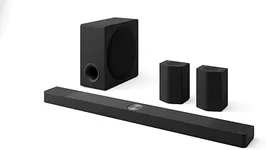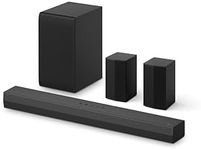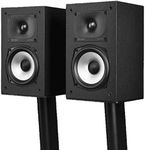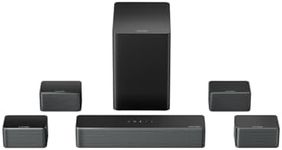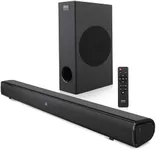Buying Guide for the Best Rear Surround Speakers
Choosing the right rear-surround speakers can significantly enhance your home theater experience by providing immersive sound that makes you feel like you're part of the action. To make an informed decision, it's important to understand the key specifications and how they align with your needs and preferences. Here are the main specs to consider when selecting rear-surround speakers.Speaker TypeThe type of speaker refers to its design and intended use. Rear-surround speakers can be bookshelf, satellite, or in-wall/in-ceiling types. Bookshelf speakers are larger and can deliver more powerful sound, making them suitable for larger rooms. Satellite speakers are smaller and more discreet, ideal for compact spaces. In-wall or in-ceiling speakers are built into the walls or ceiling, providing a clean look and saving space. Choose the type that fits your room layout and aesthetic preferences.
Frequency ResponseFrequency response indicates the range of sounds the speaker can reproduce, measured in Hertz (Hz). A wider frequency range means the speaker can produce both deep bass and high treble sounds. For rear-surround speakers, a range of around 80 Hz to 20,000 Hz is typically sufficient, as they are mainly responsible for ambient and directional sounds rather than deep bass. Consider your overall sound system and ensure the rear-surround speakers complement the other speakers in your setup.
SensitivitySensitivity measures how effectively a speaker converts power into sound, expressed in decibels (dB). Higher sensitivity means the speaker can produce louder sound with less power. Sensitivity ratings typically range from 85 dB to 100 dB. If you have a lower-powered amplifier or receiver, look for speakers with higher sensitivity (90 dB or above) to ensure they can produce adequate volume. For more powerful systems, sensitivity is less critical but still worth considering for overall efficiency.
ImpedanceImpedance is the resistance a speaker offers to the electrical current from the amplifier, measured in ohms. Common impedance ratings are 4, 6, and 8 ohms. Most home theater receivers are designed to work with 8-ohm speakers, but some can handle lower impedance speakers. Ensure the impedance of your rear-surround speakers matches or is compatible with your amplifier or receiver to avoid potential damage and ensure optimal performance.
Power HandlingPower handling indicates the amount of power a speaker can handle, measured in watts (W). It includes both continuous (RMS) and peak power ratings. Continuous power is the amount the speaker can handle over long periods, while peak power is the maximum it can handle in short bursts. Match the power handling of your rear-surround speakers with the output of your amplifier or receiver to ensure they can handle the power without distortion or damage. For most home setups, rear-surround speakers with an RMS rating of 50-150 watts are sufficient.
Build Quality and MaterialsThe build quality and materials of the speaker affect its durability and sound quality. Look for speakers with sturdy cabinets made from materials like MDF (medium-density fiberboard) and high-quality drivers (the components that produce sound). Well-built speakers will last longer and provide better sound performance. Consider the environment where the speakers will be placed; for example, if they will be in a humid area, look for moisture-resistant materials.
Size and PlacementThe size of the rear-surround speakers and their placement in your room can impact the overall sound experience. Larger speakers can produce more powerful sound but may be more challenging to place discreetly. Consider the available space and how the speakers will fit into your room layout. Proper placement is crucial for achieving the best surround sound effect, typically at ear level and slightly behind the listening position. Adjustable mounting options can help achieve the ideal placement.
